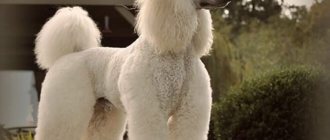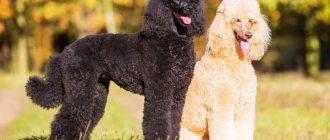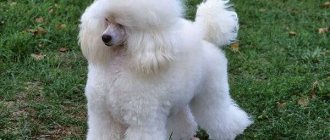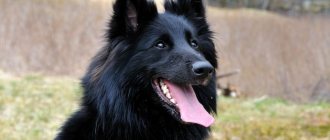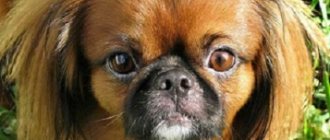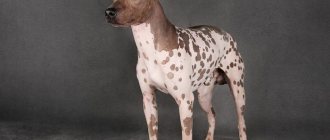The poodle is a widespread, decorative, non-sporting breed of dog. This is a gun dog, hunting dog and companion dog.
This breed was bred for hunting purposes. The dog, during the hunt, helped people by removing killed or wounded game from the water.
The Poodle is a lively, playful, loving breed of dog, ideal for families, young couples, seniors, and one owner.
The history of the poodle breed
Many people believe that poodles were bred in France. Another opinion has been put forward - the homeland of four-legged friends is Germany, since the word pudel itself is of German origin.
There is a version that the ancestors of poodles were French Barbet water dogs. It is believed that this breed acquired its final form in the 1800s.
Initially, the poodle was perceived as a hunting dog that brought hunters' prey from the water. Later, troupes of stray actors began to use smart dogs who wanted to please people in their productions. Poodle dogs also performed in the circus. Representatives of the French aristocracy were delighted with the character and appearance of the animal with luxurious fur, which was cut in every possible way.
The poodle has been known in Europe since the 16th - 17th centuries. Initially, as mentioned above, poodles took part in hunting water and forest game, including birds. In Russia they hunted ducks with poodles. This breed was also considered as a herding breed.
In the 18th century, large poodles were used on the battlefield to search for the wounded and provide field communications. The first poodle breed standards appeared in England in 1886 and in Germany in 1904.
Over time, poodles began to be considered elegant aristocrats. In ancient times, poodle dogs could only belong to royalty. This is where the name “large royal poodle” comes from. However, it is worth paying attention to the fact that in France dogs are still called caniches, which means “duck dog”.
Don't leave your dog alone... Book a foster/nanny!
Find out more
submit your application
Video
* We invite you to watch a video about the Poodle . In fact, in front of you is a playlist in which you can select and watch any of 20 videos about a given dog breed by simply clicking on the button in the upper right corner of the window. In addition, the material contains quite a lot of photos. By looking at them you can find out what a Poodle looks like.
In this article:
|
Characteristics of the Poodle breed
The lifespan of a dog is from ten to fourteen years. The Poodle breed has a low predisposition to drooling and snoring. The dog has a moderate tendency to bark and a low tendency to dig. The poodle breed is considered an excellent jumper. Pets have a high need for grooming.
The Poodle breed also excels in the role of a guide dog and is a good police dog. Dogs are repeatedly used in dog competitions for agility and obedience, in dog sled races, and to guard livestock.
It is worth noting that the poodle ranks second in the ranking of the smartest breeds, which was compiled by Dr. Stanley Coren. Dogs of this breed grasp everything on the fly, so they are easy to train.
The poodle shows a pronounced tendency to hunt duck, pheasant, and hare. They have excellent instincts. Poodles adapt to any climatic conditions. Bitches usually give birth to three or four puppies.
References
- ^ abc Alderton, David (1987). The Dog: The Most Comprehensive Illustrated Practical Guide to Dogs and Their World
. London: New Burlington Books. pp. 87–88. ISBN 0-948872-13-6. - ^ B s d e g Alderton, David (2008). Encyclopedia of Dogs
. Bath: Parragon Books Ltd., pp. 131 and 354. ISBN 978-1-4454-0853-8. - ^ B s d e g h i JKL Fogle, Bruce (2009). Encyclopedia of Dogs
. New York: DK Publishing. pp. 68–69, 190 and 282. ISBN 978-0-7566-6004-8. - ^ abc Hancock, David (2013). Gundogs: Their Past, Their Performances and Their Prospects
. Ramsbury, Marlborough: Crowood Press Ltd., pp. 33 and 37–38. ISBN 978-1-84797-492-1. - ^ B s d e g h i J k l m Morris, Desmond (2001). Dogs: A Complete Dictionary of Over 1,000 Dog Breeds
. North Pomfret, VT: Trafalgar Square Publishing. pp. 295–297 and 526–529. ISBN 1-57076-219-8. - ^ abcd "FCI Standard No. 172: Poodle" (PDF). International Canine Federation
. January 23, 2015. Retrieved March 21, 2022. - ^ abc Fiorone, Fiorenzo (1973). Encyclopedia of Dogs: Dog Breeds
. New York: Thomas Y. Cromwell Company. pp. 377–381. ISBN 0-690-00056-1. - ↑
Grady, Denise (February 5, 1997).
“Non-allergenic dog? Not really" . New York Times
. Archived from the original on January 30, 2009. Retrieved April 21, 2011. How hypoallergenic a dog is may vary depending on the individual dog and individual. - ^ a b "Poodle". American Kennel Club. Retrieved February 7, 2022.
- ↑
United Kennel Club: Standard Poodle Breed Standard. Retrieved May 12, 2007." Archived from the original on November 11, 2006. - Guardian, Ann Geggis, Sun "Famous Boca Raton Poodle from London Wins for World Title". Sun-Sentinel.com
. Retrieved March 4, 2022. - "Poodle (Standard): Dog Breed Selector: Animal Planet". Animal Planet
. Archived from the original on February 18, 2015. Retrieved December 11, 2014. - "Poodles are ready to hunt". Denverpost.com. February 19, 2008. Archived December 11, 2014. Retrieved December 11, 2014.
- Cawthorne, Nigel (2012). Canine Commandos: Heroism, Devotion, and Dog Sacrificing in War. Ulysses Press. ISBN 9781612430553.
Poodle dog appearance, colors
The weight of an adult dog ranges from three to thirty-two kilograms. The poodle has a long, fox-like muzzle. His ears in their natural position are floppy. The poodle breed is characterized by a long, dense coat. The animal's fur is curly.
A dog accepted for exhibition must have a uniform coat color. The colors of poodles are as follows: black, gray, sable, white, silver, blue, apricot, chocolate, cream and even brown-red.
There are such types of poodles - toy poodle, miniature poodle, standard poodle, small (dwarf) poodle. Standard poodles are over forty centimeters tall and weigh between twenty and thirty-two kilograms.
Miniature poodles are characterized by a height of less than twenty centimeters and a weight of five to eight kilograms. Small poodles are less than twenty centimeters at the withers. Their weight ranges from three to five kilograms.
Poodles have a characteristic square silhouette. The dogs have a long neck, which gives them elegance, and a straight back. The dog's tail is docked in such a way that the pet can wag it. The poodle has an attentive and lively look. The eyes are characterized by an almond shape. A poodle's ears are soft and rectangular in shape. The tips of the ears are rounded. When the dog shows interest, his ears rise and turn slightly forward.
The poodle has small, proportional limbs with strong joints and neat pads. The dog's paws are long.
The poodle has a springy gait. When moving, the dog looks cheerful.
Owner reviews
Most owners speak of poodles as wonderful companions who sincerely love their owners and get along well with children. There are also positive reviews about the intelligence of the pets and the ease of their training.
Among the disadvantages are the need for careful care of the coat, changeable character, frequent illnesses in puppyhood, and hyperactive behavior.
As a conclusion, we can say the following. Poodles are excellent dogs for living in apartment conditions, especially the small, dwarf and toy varieties. A royal pet will need quite a lot of space. Despite all the positive qualities, it is worth remembering that a dog is not a toy, and it will need to be given attention, as well as properly raised, in order to ultimately become a worthy family member.
Poodle character, care
The Poodle is a delicate breed of dog. Animals are distinguished by their special intelligence and intelligence.
Poodles are cheerful, agile, obedient family dogs who are not averse to fooling around. The Poodle is a fun dog that won't sit in a kennel.
The poodle dog breed is very energetic. The dog has a high need for attention and communication with people. Four-legged friends are passionate and active, they love to be surrounded by family members. If a poodle is left alone for a long time, it begins to demand attention and bark loudly.
The Poodle is a good protector of its own home and family members. Young dogs can be aggressive towards strangers and other dogs. In order for a pet to behave calmly, it must be socialized. You should start accustoming your dog to other people and animals from puppyhood.
Poodles very often take part in exhibitions. The dog requires grooming services. Poodles have a special haircut that is a specific combination of thick and short hair. Groomers leave thick fur on the dog's chest and limbs, which protects the animal from hypothermia in icy water.
Some owners prefer a short haircut for the dog, in which the hair remains only on the head and the tip of the tail. Sometimes, at the request of the owners, the guard hairs and undercoat hairs are intertwined with the four-legged ones. Long, dreadlock-like, hanging cords are formed.
The poodle breed does not shed. Dead old hair curls into nearby hairs, so the dog needs to be brushed and trimmed regularly. If this is not done on time, the resulting lumps will cause unpleasant, painful sensations to the dog.
In addition to daily grooming, the dog needs frequent baths and nourishing the coat with special care products. Owners often tie the hairs on a dog's head into a ponytail.
Poodle dogs easily adapt to different living conditions. They can feel great both in a city apartment and a country house. The only condition is that you need to take your dog for walks every day. Also, a poodle dog should get enough exercise in the fresh air. Poodles often take part in the dog sport of agility, which involves jumping through an obstacle course.
Tired, want to relax? Book a dog walk!
Find out more
submit your application
Health
A toy poodle, if all rules of maintenance and care are followed by the owner, can live up to 18-19 years. Moreover, the average life expectancy of these dogs is 14-16 years.
It cannot be said that a toy poodle has strong immunity and good health. These are animals that need care, they need to be well taken care of and the condition of the body must be closely monitored.
It is mandatory for a toy poodle to undergo examinations at a veterinary clinic 1-2 times a year. Deworming, vaccinations and treatment with anti-parasite medications are also required.
The owner of a toy poodle should familiarize himself with the diseases to which this breed is predisposed:
- Narcolepsy is a neurological disorder characterized by disturbances in nighttime sleep, persistent daytime sleepiness, and sudden “falling asleep” during the day.
- Cardiomyopathy – leads to the development of congestive heart failure.
- Urolithiasis is a pathology of the urinary system.
- Medial luxation of the patella is a genetic disease.
- Hair loss can occur as a result of severe stress.
- Diabetes mellitus is an endocrine disease that cannot be treated, but it can be controlled.
- Hydrocephalus is a congenital disease characterized by excessive formation and accumulation of cerebrospinal fluid in the cerebral ventricles.
- Caries is the destruction of hard dental tissue.
- Hypoglycemia is a decrease in blood sugar levels.
- Cryptorchidism is a hereditary anomaly in which the testicles are undescended into the scrotum.
- Tracheal collapse is a genetic, chronic degenerative disease associated with anatomical deformation of the tracheal rings.
- Inflammation of the tonsils - inflammation of the palatine tonsils, caused by coccal microorganisms, develops as a concomitant with plague and hepatitis.
- Damage to the anal glands - characterized by swelling and minor damage to the skin around the anus.
- Epilepsy - characterized by convulsions, seizures with involuntary urination.
- Hypothyroidism is insufficient or absent production of thyroid hormone.
- Immune hemolytic anemia is a disease of the immune system.
- Hemorrhagic gastroenteritis is an acute disorder characterized by vomiting and bloody diarrhea.
- Eye diseases – glaucoma, cataracts, retinal detachment, death.
- Chronic insufficiency in the atrioventricular valves - a chronic cough develops, sometimes with shortness of breath and cyanosis.
- Von Willebrand disease develops when there is a defective von Willebrand factor in the blood or a deficiency of it in the blood.
- Cushing's syndrome or hyperadrenocorticism is a disease of the endocrine system.
- Disorders between the discs of the spine lead to weakness of the limbs and limited movement.
Feeding a poodle dog
It is very important for a poodle puppy to have proper nutrition. This is necessary for the full growth and development of the dog. However, it should be remembered that there is a tendency for the poodle to gain excess weight when fed in excess of the norm.
The dog can be given both natural food and ready-made, store-bought, dry food. The choice of food depends on the owner’s employment and financial capabilities.
If a dog owner prefers natural nutrition, he must select only high-quality products. A natural diet for feeding a poodle should include both plant and animal foods, for example, meat (beef) and offal, sea fish and boiled chicken eggs, cereals - rice, rolled oats, millet, buckwheat, milk and fermented milk products, crackers and bread, vegetables and fruits.
For small (by age) dogs, pasta, fresh bread, thick cereals, salty, fried foods, fatty meats, spices, smoked meats, and sweets are undesirable. It is not recommended to give your dog boiled bones, boiled potatoes and legumes.
If a poodle is switched to dry food, then preference should be given to high-quality premium food. Several times a week you can pamper your dog with wet poodle food.
A balanced food is considered ideal, containing all the fats, proteins, carbohydrates, minerals and vitamins necessary for a dog.
The frequency of feeding your dog depends on its age. The size of the pet also affects food intake. Puppies, at three months of age, should be fed four or five times a day. Upon reaching six months of age, the dog is transferred to three feedings a day. For a dog approaching twelve months of age or older, two meals per day will be enough.
The size of the servings also depends on the age of the dog and its size. Meat and dairy products should account for two-thirds of a poodle's daily food intake. It is also very important that the dog always has free access to clean, fresh water.
Poodle training
Training a poodle is not difficult because the dog is smart, attentive and active. The dog has a keen intellect. This breed is ideal for an inexperienced owner. It should be remembered that the dog has a sense of self-esteem and must be treated as equals, with respect.
The Poodle breed is very observant. She is interested in interacting with people. The dog is easy to train. Has an increased interest in training.
If a person finds a competent approach to this breed of dog, it will consistently demonstrate the acquired skills. The Poodle has a tendency to serve and work hard. He is able to master absolutely any command.
Hypoallergenic qualities
Poodles are often referred to as a hypoallergenic dog breed. Their individual hair follicles have a longer period of active growth than many other dog breeds; Combined with a tightly curled coat, which slows the loss of dandruff and dead hair by keeping it in locks, the individual Poodle may shed less dander and hair into the environment. Additionally, most poodles are brushed and bathed frequently to keep them looking good; This not only removes hair and dandruff, but also controls another powerful allergen - saliva.
Although the amount of hair, dandruff and saliva can be kept to a minimum, they are still present and can stick to “clothing, carpets and furniture in your home”; Inhaling them or having a dog lick them can cause a reaction in a sensitive person. An air purifier, air duct outlet, and vacuuming with a HEPA filter can help get rid of dandruff floating in the air.


